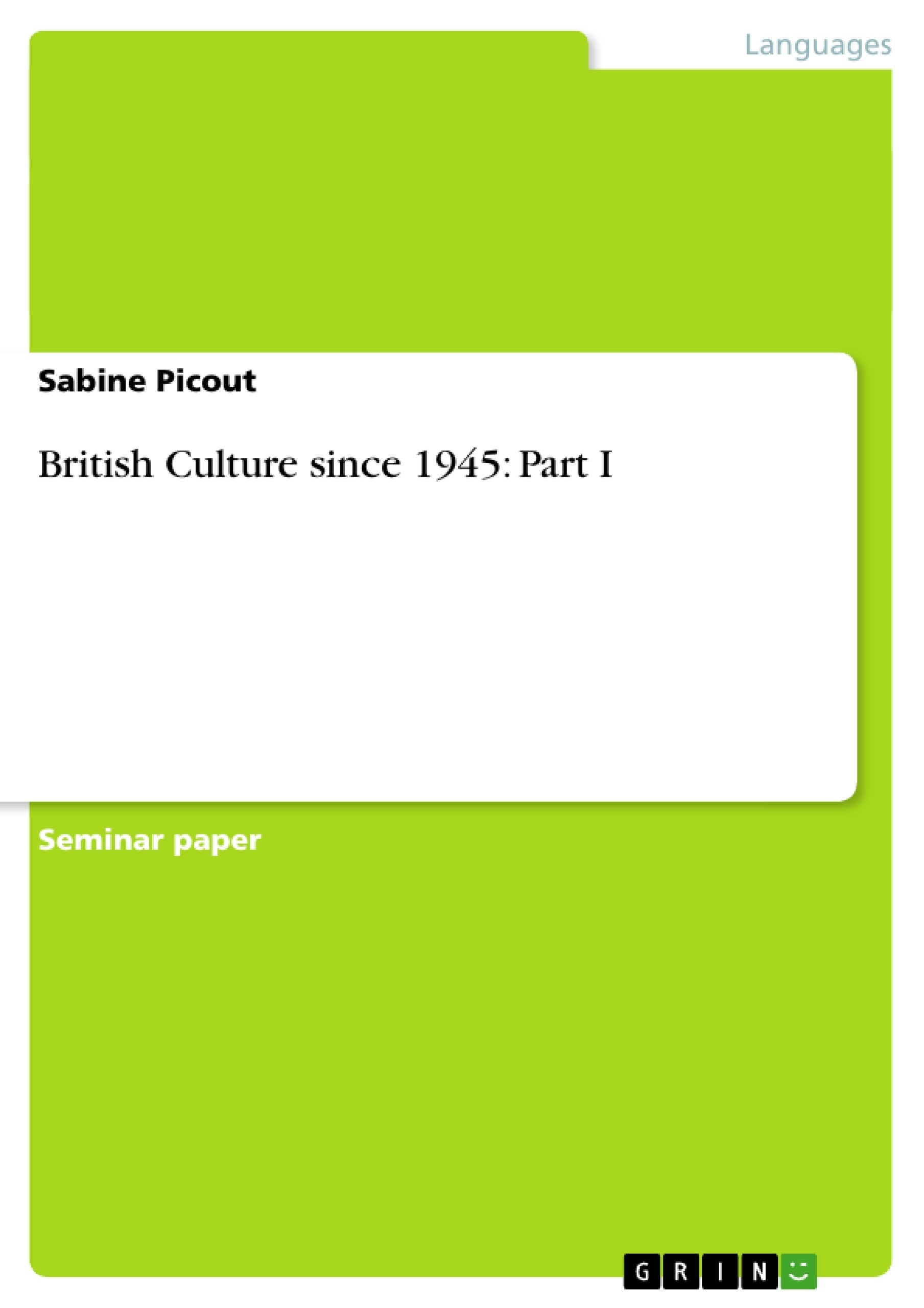This paper gives an overview on the most important cornerstones of British culture from 1945 to 1970 and gives answers in bullet points to following questions: I. Identify 6 aims of the book (British Culture – An Introduction (David Christopher, Routledge 1999)). II. In which practical ways can you access information and comment on the
Arts in Britain today? III. The Social and Cultural Context:
Explain the post-war impact in Britain of ethnicity, feminism, youth. IV. Why is 1979 a radical turning-point in arts subsidy? V. 1945 - 1970 --> 1. What did the 1951 Festival of Britain mark? 2. Explain the roots of Reggae in Britain. 3. Which image of London’s Notting Hill is offered in the film of the same name? 4. What do Benjamin Britten, Henry Moore, E.M. Forster and Doris Lessing have in common? 5. 5) Explain the socio-cultural context of Penguin’s Lady Chatterley Trial. 6. Which social issues did ‘social realism’ in the arts deal with in the mid/late 1950s? 7. Explain how dissent was introduced into the arts. 8. Which cultural viewpoint did F.R. Leavis hold? Compare his with Richard Hoggart’s. 9. Which socio-cultural changes did Labour usher in after 1964? 10. Find out about Margaret Drabble’s novel The Millstone. How does it relate to pp 6-7? 11. In which ways are the following representative of the mid-1960s? James Bond, George Best (born in 1946), Twiggy, The Avengers, The Beatles, The Rolling Stones.
Inhaltsverzeichnis (Table of Contents)
- British Culture – An Introduction
- The Social and Cultural Context
- Why is 1979 a radical turning-point in arts subsidy?
- 1945 - 1970
Zielsetzung und Themenschwerpunkte (Objectives and Key Themes)
This text, "British Culture – An Introduction" aims to provide an overview of key cultural tendencies and movements in Britain since 1945, highlighting historical context, notable figures, and significant events. It explores the evolution of British culture, encompassing the impact of various factors such as the decline of the British Empire, the rise of feminism, and the cultural influence of new immigrant groups.
- Cultural Change and Continuity in Post-War Britain
- Impact of Immigration and Ethnicity on British Culture
- Feminist Movement and Its Influence on British Society
- The Role of the Arts in Shaping British Society
- The Shift in Arts Funding and the Rise of Individualism
Zusammenfassung der Kapitel (Chapter Summaries)
- British Culture – An Introduction: This chapter introduces the book's objectives, including outlining major cultural movements, highlighting the dynamic nature of culture, and offering historical context. It also explores the impact of the decline of the British Empire and the rise of the feminist movement on British culture.
- The Social and Cultural Context: This section delves into the social and cultural transformations that shaped Britain in the post-war era. It examines the impact of immigration on British society, particularly the influx of immigrants from the Commonwealth, and the subsequent rise of racial tensions. The section also explores the changing role of women in British society, analyzing the impact of the feminist movement and its influence on legislation regarding abortion, family planning, and divorce. It also addresses the demographic shift towards a younger population and its influence on cultural trends.
- Why is 1979 a radical turning-point in arts subsidy? This section examines the significant shift in government arts funding in 1979. It discusses the shift from government subsidies towards a more market-driven approach, highlighting the influence of the Conservative government's policies and their impact on the arts.
- 1945 - 1970: This section delves into the cultural landscape of Britain in the years following World War II. It examines the significance of the 1951 Festival of Britain and its role in celebrating the nation's recovery and growth. It also sheds light on the economic boom, the increase in consumerism, and the growing demand for manual labor, leading to the influx of immigrants from the Commonwealth.
Schlüsselwörter (Keywords)
The key terms and concepts explored in this text include British culture, post-war era, cultural change, immigration, ethnicity, racial tensions, feminism, the arts, arts funding, government subsidies, market-driven approach, consumerism, economic growth, and social trends.
- Citation du texte
- MMag. Dr. Sabine Picout (Auteur), 2004, British Culture since 1945: Part I, Munich, GRIN Verlag, https://www.grin.com/document/189877



